Leadership and Management Report: John Lewis Case Study Analysis
VerifiedAdded on 2023/01/12
|15
|4377
|58
Report
AI Summary
This report delves into the multifaceted world of leadership and management, examining the distinct roles of leaders and managers within an organizational context, specifically referencing the British multinational company John Lewis. The report explores various leadership theories, including transformational, classical management, situational, system, and contingency leadership, analyzing their strengths and weaknesses. It further investigates how leaders and managers function in diverse conditions, such as rapid changes and conflict resolution, and discusses different leadership styles. The report also covers operational management, examining different approaches and the factors that influence it, providing a comprehensive overview of leadership and management principles and their practical application within a business environment. The analysis includes a critical evaluation of the discussed theories and their impact on organizational effectiveness. The report covers topics such as management and operations, roles and responsibilities of managers and leaders, leadership styles, and different leadership theories and their application. The report also emphasizes the importance of effective communication and the ability to set a vision to achieve the goals of the organization.
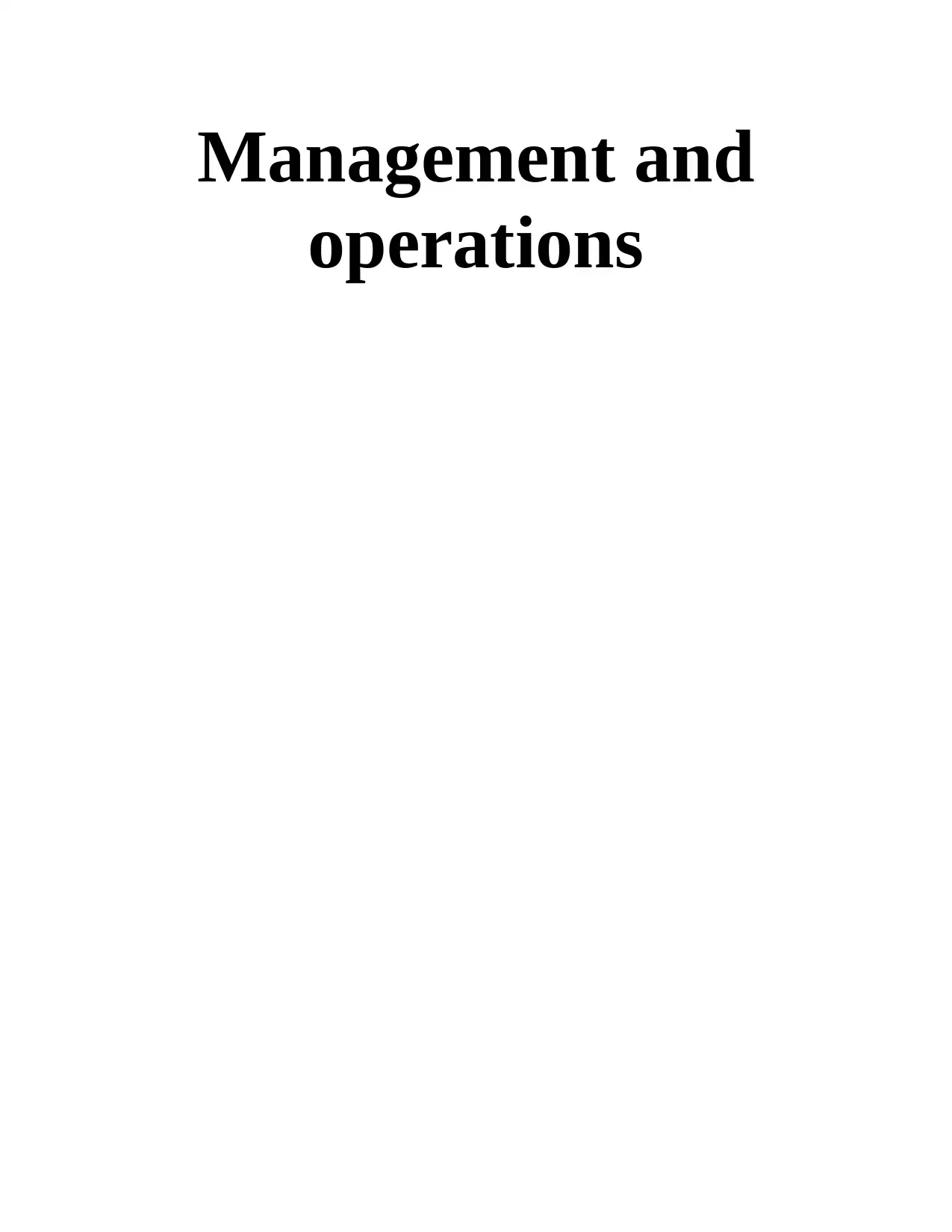
Management and
operations
operations
Secure Best Marks with AI Grader
Need help grading? Try our AI Grader for instant feedback on your assignments.

Table of Contents
Introduction:.....................................................................................................................................1
TASK 1:...........................................................................................................................................1
LO1:.................................................................................................................................................1
P1: Examine and compare the roles of the leader and manager in the organisation.............1
M1: Analyse and make a distinction between the role of the leader and function of the
manager in applying to range of theories and concepts........................................................3
TASK 2:...........................................................................................................................................3
Lo2:..................................................................................................................................................3
P2: Explain the how leader and manager function apply in the different condition:...........3
P3: Discuss different leadership style and theories in the organisation:..............................4
M2: discuss the strength and weakness of different leadership theories...............................5
D1: Critically evaluate the different theories and its approaches:........................................6
LO3:.................................................................................................................................................6
P4: examine different approaches to operation management and role of the leader and
manager:.................................................................................................................................6
P5: explain the importance of operation management in achieving the objectives of the
organisation............................................................................................................................7
M3: Evaluate the ways leader and manager can improve effectiveness of the operational
management............................................................................................................................8
D2: Critically Evaluate application of operations management:............................................8
LO4:.................................................................................................................................................8
P6: Disuses the factors within the business environment that affect the operational
management............................................................................................................................8
M4: Analyse how different factors affects the work environment.:.....................................9
Conclusion:....................................................................................................................................10
References:.....................................................................................................................................10
Introduction:.....................................................................................................................................1
TASK 1:...........................................................................................................................................1
LO1:.................................................................................................................................................1
P1: Examine and compare the roles of the leader and manager in the organisation.............1
M1: Analyse and make a distinction between the role of the leader and function of the
manager in applying to range of theories and concepts........................................................3
TASK 2:...........................................................................................................................................3
Lo2:..................................................................................................................................................3
P2: Explain the how leader and manager function apply in the different condition:...........3
P3: Discuss different leadership style and theories in the organisation:..............................4
M2: discuss the strength and weakness of different leadership theories...............................5
D1: Critically evaluate the different theories and its approaches:........................................6
LO3:.................................................................................................................................................6
P4: examine different approaches to operation management and role of the leader and
manager:.................................................................................................................................6
P5: explain the importance of operation management in achieving the objectives of the
organisation............................................................................................................................7
M3: Evaluate the ways leader and manager can improve effectiveness of the operational
management............................................................................................................................8
D2: Critically Evaluate application of operations management:............................................8
LO4:.................................................................................................................................................8
P6: Disuses the factors within the business environment that affect the operational
management............................................................................................................................8
M4: Analyse how different factors affects the work environment.:.....................................9
Conclusion:....................................................................................................................................10
References:.....................................................................................................................................10
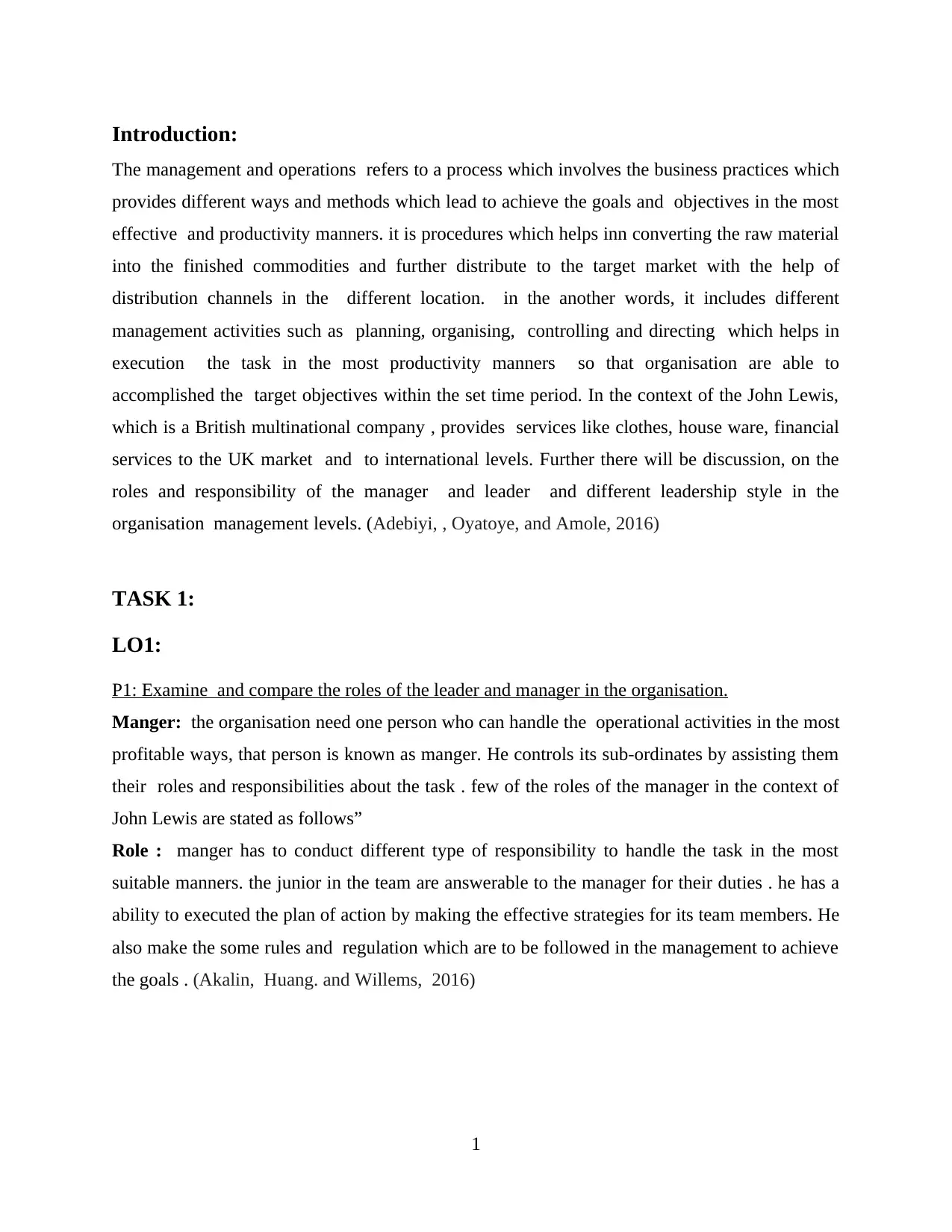
Introduction:
The management and operations refers to a process which involves the business practices which
provides different ways and methods which lead to achieve the goals and objectives in the most
effective and productivity manners. it is procedures which helps inn converting the raw material
into the finished commodities and further distribute to the target market with the help of
distribution channels in the different location. in the another words, it includes different
management activities such as planning, organising, controlling and directing which helps in
execution the task in the most productivity manners so that organisation are able to
accomplished the target objectives within the set time period. In the context of the John Lewis,
which is a British multinational company , provides services like clothes, house ware, financial
services to the UK market and to international levels. Further there will be discussion, on the
roles and responsibility of the manager and leader and different leadership style in the
organisation management levels. (Adebiyi, , Oyatoye, and Amole, 2016)
TASK 1:
LO1:
P1: Examine and compare the roles of the leader and manager in the organisation.
Manger: the organisation need one person who can handle the operational activities in the most
profitable ways, that person is known as manger. He controls its sub-ordinates by assisting them
their roles and responsibilities about the task . few of the roles of the manager in the context of
John Lewis are stated as follows”
Role : manger has to conduct different type of responsibility to handle the task in the most
suitable manners. the junior in the team are answerable to the manager for their duties . he has a
ability to executed the plan of action by making the effective strategies for its team members. He
also make the some rules and regulation which are to be followed in the management to achieve
the goals . (Akalin, Huang. and Willems, 2016)
1
The management and operations refers to a process which involves the business practices which
provides different ways and methods which lead to achieve the goals and objectives in the most
effective and productivity manners. it is procedures which helps inn converting the raw material
into the finished commodities and further distribute to the target market with the help of
distribution channels in the different location. in the another words, it includes different
management activities such as planning, organising, controlling and directing which helps in
execution the task in the most productivity manners so that organisation are able to
accomplished the target objectives within the set time period. In the context of the John Lewis,
which is a British multinational company , provides services like clothes, house ware, financial
services to the UK market and to international levels. Further there will be discussion, on the
roles and responsibility of the manager and leader and different leadership style in the
organisation management levels. (Adebiyi, , Oyatoye, and Amole, 2016)
TASK 1:
LO1:
P1: Examine and compare the roles of the leader and manager in the organisation.
Manger: the organisation need one person who can handle the operational activities in the most
profitable ways, that person is known as manger. He controls its sub-ordinates by assisting them
their roles and responsibilities about the task . few of the roles of the manager in the context of
John Lewis are stated as follows”
Role : manger has to conduct different type of responsibility to handle the task in the most
suitable manners. the junior in the team are answerable to the manager for their duties . he has a
ability to executed the plan of action by making the effective strategies for its team members. He
also make the some rules and regulation which are to be followed in the management to achieve
the goals . (Akalin, Huang. and Willems, 2016)
1
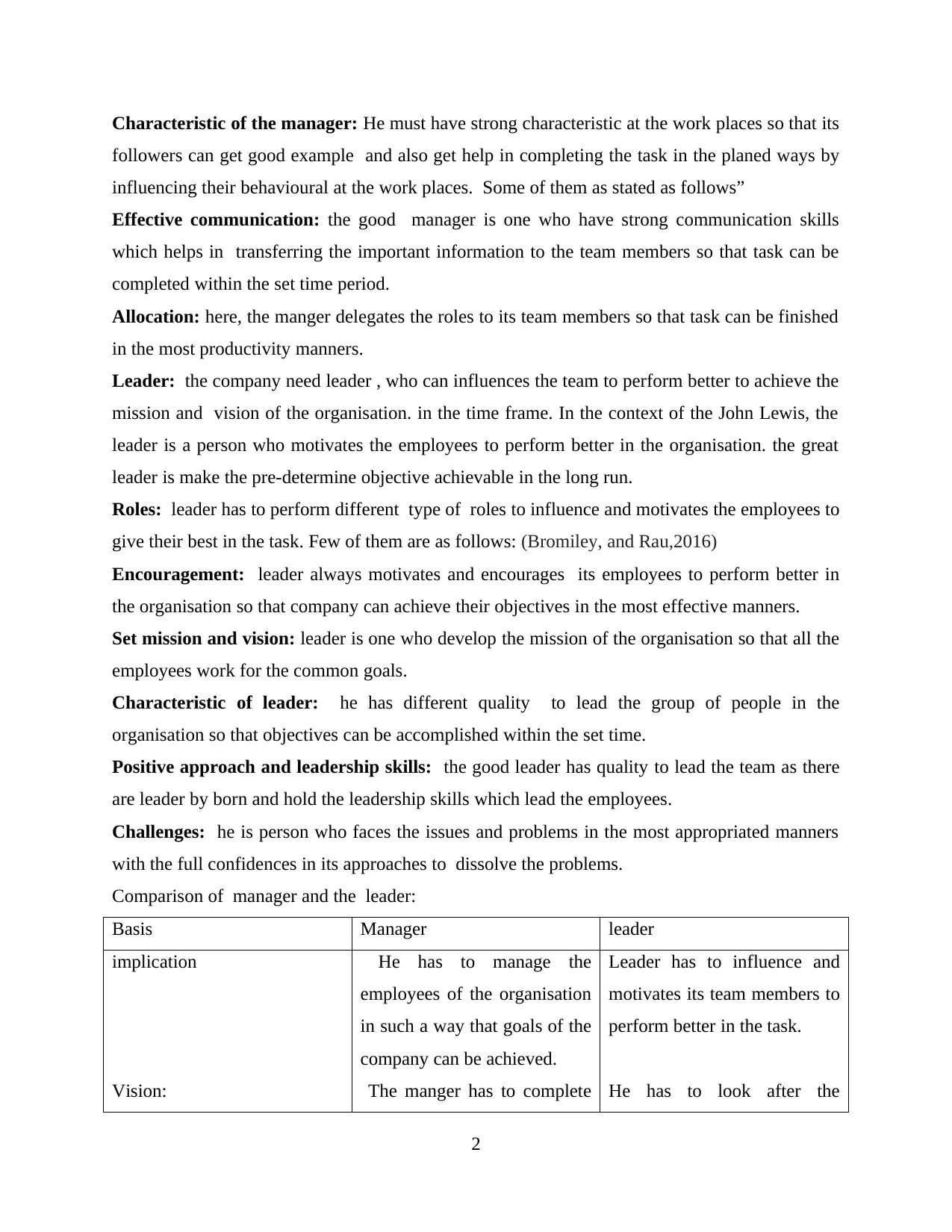
Characteristic of the manager: He must have strong characteristic at the work places so that its
followers can get good example and also get help in completing the task in the planed ways by
influencing their behavioural at the work places. Some of them as stated as follows”
Effective communication: the good manager is one who have strong communication skills
which helps in transferring the important information to the team members so that task can be
completed within the set time period.
Allocation: here, the manger delegates the roles to its team members so that task can be finished
in the most productivity manners.
Leader: the company need leader , who can influences the team to perform better to achieve the
mission and vision of the organisation. in the time frame. In the context of the John Lewis, the
leader is a person who motivates the employees to perform better in the organisation. the great
leader is make the pre-determine objective achievable in the long run.
Roles: leader has to perform different type of roles to influence and motivates the employees to
give their best in the task. Few of them are as follows: (Bromiley, and Rau,2016)
Encouragement: leader always motivates and encourages its employees to perform better in
the organisation so that company can achieve their objectives in the most effective manners.
Set mission and vision: leader is one who develop the mission of the organisation so that all the
employees work for the common goals.
Characteristic of leader: he has different quality to lead the group of people in the
organisation so that objectives can be accomplished within the set time.
Positive approach and leadership skills: the good leader has quality to lead the team as there
are leader by born and hold the leadership skills which lead the employees.
Challenges: he is person who faces the issues and problems in the most appropriated manners
with the full confidences in its approaches to dissolve the problems.
Comparison of manager and the leader:
Basis Manager leader
implication
Vision:
He has to manage the
employees of the organisation
in such a way that goals of the
company can be achieved.
The manger has to complete
Leader has to influence and
motivates its team members to
perform better in the task.
He has to look after the
2
followers can get good example and also get help in completing the task in the planed ways by
influencing their behavioural at the work places. Some of them as stated as follows”
Effective communication: the good manager is one who have strong communication skills
which helps in transferring the important information to the team members so that task can be
completed within the set time period.
Allocation: here, the manger delegates the roles to its team members so that task can be finished
in the most productivity manners.
Leader: the company need leader , who can influences the team to perform better to achieve the
mission and vision of the organisation. in the time frame. In the context of the John Lewis, the
leader is a person who motivates the employees to perform better in the organisation. the great
leader is make the pre-determine objective achievable in the long run.
Roles: leader has to perform different type of roles to influence and motivates the employees to
give their best in the task. Few of them are as follows: (Bromiley, and Rau,2016)
Encouragement: leader always motivates and encourages its employees to perform better in
the organisation so that company can achieve their objectives in the most effective manners.
Set mission and vision: leader is one who develop the mission of the organisation so that all the
employees work for the common goals.
Characteristic of leader: he has different quality to lead the group of people in the
organisation so that objectives can be accomplished within the set time.
Positive approach and leadership skills: the good leader has quality to lead the team as there
are leader by born and hold the leadership skills which lead the employees.
Challenges: he is person who faces the issues and problems in the most appropriated manners
with the full confidences in its approaches to dissolve the problems.
Comparison of manager and the leader:
Basis Manager leader
implication
Vision:
He has to manage the
employees of the organisation
in such a way that goals of the
company can be achieved.
The manger has to complete
Leader has to influence and
motivates its team members to
perform better in the task.
He has to look after the
2
Secure Best Marks with AI Grader
Need help grading? Try our AI Grader for instant feedback on your assignments.
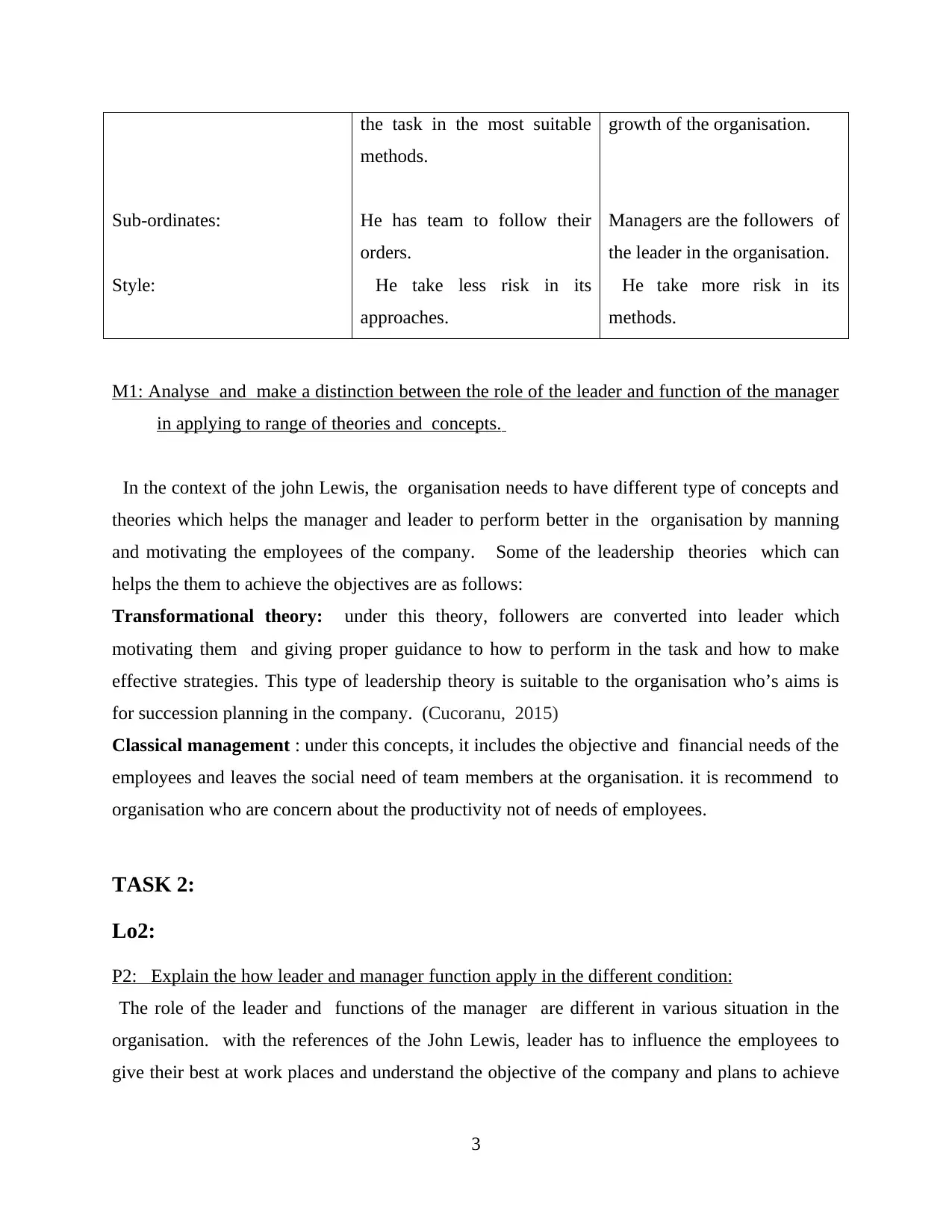
Sub-ordinates:
Style:
the task in the most suitable
methods.
He has team to follow their
orders.
He take less risk in its
approaches.
growth of the organisation.
Managers are the followers of
the leader in the organisation.
He take more risk in its
methods.
M1: Analyse and make a distinction between the role of the leader and function of the manager
in applying to range of theories and concepts.
In the context of the john Lewis, the organisation needs to have different type of concepts and
theories which helps the manager and leader to perform better in the organisation by manning
and motivating the employees of the company. Some of the leadership theories which can
helps the them to achieve the objectives are as follows:
Transformational theory: under this theory, followers are converted into leader which
motivating them and giving proper guidance to how to perform in the task and how to make
effective strategies. This type of leadership theory is suitable to the organisation who’s aims is
for succession planning in the company. (Cucoranu, 2015)
Classical management : under this concepts, it includes the objective and financial needs of the
employees and leaves the social need of team members at the organisation. it is recommend to
organisation who are concern about the productivity not of needs of employees.
TASK 2:
Lo2:
P2: Explain the how leader and manager function apply in the different condition:
The role of the leader and functions of the manager are different in various situation in the
organisation. with the references of the John Lewis, leader has to influence the employees to
give their best at work places and understand the objective of the company and plans to achieve
3
Style:
the task in the most suitable
methods.
He has team to follow their
orders.
He take less risk in its
approaches.
growth of the organisation.
Managers are the followers of
the leader in the organisation.
He take more risk in its
methods.
M1: Analyse and make a distinction between the role of the leader and function of the manager
in applying to range of theories and concepts.
In the context of the john Lewis, the organisation needs to have different type of concepts and
theories which helps the manager and leader to perform better in the organisation by manning
and motivating the employees of the company. Some of the leadership theories which can
helps the them to achieve the objectives are as follows:
Transformational theory: under this theory, followers are converted into leader which
motivating them and giving proper guidance to how to perform in the task and how to make
effective strategies. This type of leadership theory is suitable to the organisation who’s aims is
for succession planning in the company. (Cucoranu, 2015)
Classical management : under this concepts, it includes the objective and financial needs of the
employees and leaves the social need of team members at the organisation. it is recommend to
organisation who are concern about the productivity not of needs of employees.
TASK 2:
Lo2:
P2: Explain the how leader and manager function apply in the different condition:
The role of the leader and functions of the manager are different in various situation in the
organisation. with the references of the John Lewis, leader has to influence the employees to
give their best at work places and understand the objective of the company and plans to achieve
3
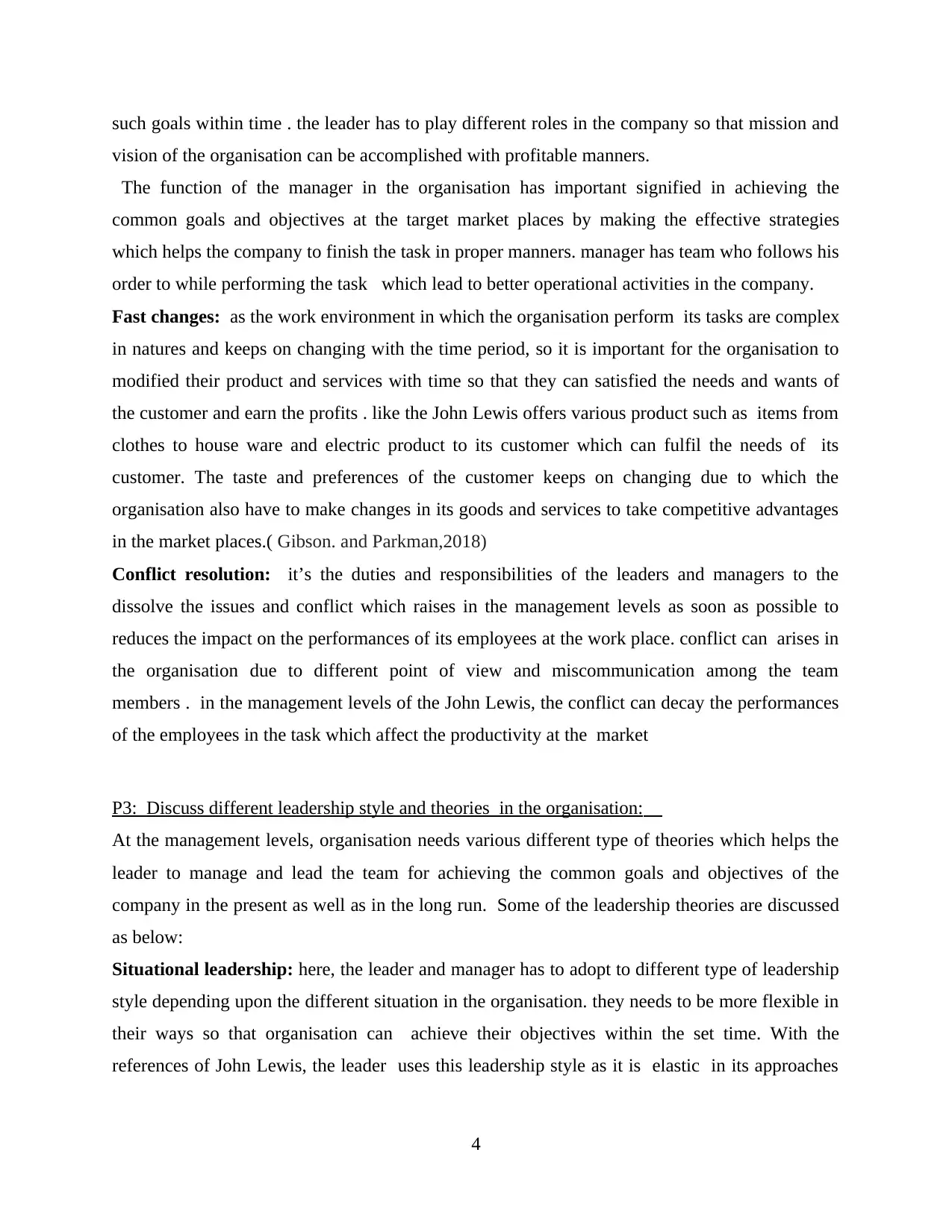
such goals within time . the leader has to play different roles in the company so that mission and
vision of the organisation can be accomplished with profitable manners.
The function of the manager in the organisation has important signified in achieving the
common goals and objectives at the target market places by making the effective strategies
which helps the company to finish the task in proper manners. manager has team who follows his
order to while performing the task which lead to better operational activities in the company.
Fast changes: as the work environment in which the organisation perform its tasks are complex
in natures and keeps on changing with the time period, so it is important for the organisation to
modified their product and services with time so that they can satisfied the needs and wants of
the customer and earn the profits . like the John Lewis offers various product such as items from
clothes to house ware and electric product to its customer which can fulfil the needs of its
customer. The taste and preferences of the customer keeps on changing due to which the
organisation also have to make changes in its goods and services to take competitive advantages
in the market places.( Gibson. and Parkman,2018)
Conflict resolution: it’s the duties and responsibilities of the leaders and managers to the
dissolve the issues and conflict which raises in the management levels as soon as possible to
reduces the impact on the performances of its employees at the work place. conflict can arises in
the organisation due to different point of view and miscommunication among the team
members . in the management levels of the John Lewis, the conflict can decay the performances
of the employees in the task which affect the productivity at the market
P3: Discuss different leadership style and theories in the organisation:
At the management levels, organisation needs various different type of theories which helps the
leader to manage and lead the team for achieving the common goals and objectives of the
company in the present as well as in the long run. Some of the leadership theories are discussed
as below:
Situational leadership: here, the leader and manager has to adopt to different type of leadership
style depending upon the different situation in the organisation. they needs to be more flexible in
their ways so that organisation can achieve their objectives within the set time. With the
references of John Lewis, the leader uses this leadership style as it is elastic in its approaches
4
vision of the organisation can be accomplished with profitable manners.
The function of the manager in the organisation has important signified in achieving the
common goals and objectives at the target market places by making the effective strategies
which helps the company to finish the task in proper manners. manager has team who follows his
order to while performing the task which lead to better operational activities in the company.
Fast changes: as the work environment in which the organisation perform its tasks are complex
in natures and keeps on changing with the time period, so it is important for the organisation to
modified their product and services with time so that they can satisfied the needs and wants of
the customer and earn the profits . like the John Lewis offers various product such as items from
clothes to house ware and electric product to its customer which can fulfil the needs of its
customer. The taste and preferences of the customer keeps on changing due to which the
organisation also have to make changes in its goods and services to take competitive advantages
in the market places.( Gibson. and Parkman,2018)
Conflict resolution: it’s the duties and responsibilities of the leaders and managers to the
dissolve the issues and conflict which raises in the management levels as soon as possible to
reduces the impact on the performances of its employees at the work place. conflict can arises in
the organisation due to different point of view and miscommunication among the team
members . in the management levels of the John Lewis, the conflict can decay the performances
of the employees in the task which affect the productivity at the market
P3: Discuss different leadership style and theories in the organisation:
At the management levels, organisation needs various different type of theories which helps the
leader to manage and lead the team for achieving the common goals and objectives of the
company in the present as well as in the long run. Some of the leadership theories are discussed
as below:
Situational leadership: here, the leader and manager has to adopt to different type of leadership
style depending upon the different situation in the organisation. they needs to be more flexible in
their ways so that organisation can achieve their objectives within the set time. With the
references of John Lewis, the leader uses this leadership style as it is elastic in its approaches
4
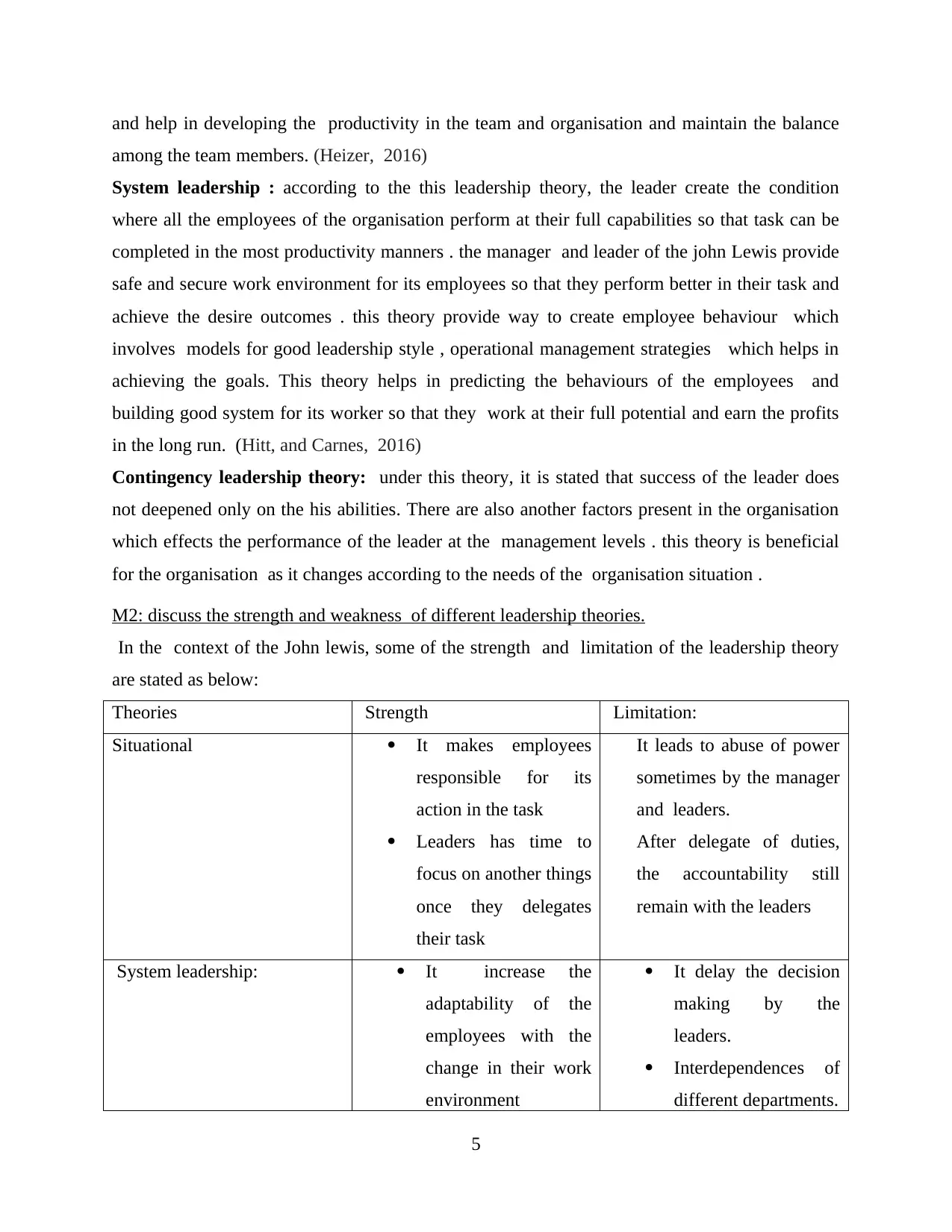
and help in developing the productivity in the team and organisation and maintain the balance
among the team members. (Heizer, 2016)
System leadership : according to the this leadership theory, the leader create the condition
where all the employees of the organisation perform at their full capabilities so that task can be
completed in the most productivity manners . the manager and leader of the john Lewis provide
safe and secure work environment for its employees so that they perform better in their task and
achieve the desire outcomes . this theory provide way to create employee behaviour which
involves models for good leadership style , operational management strategies which helps in
achieving the goals. This theory helps in predicting the behaviours of the employees and
building good system for its worker so that they work at their full potential and earn the profits
in the long run. (Hitt, and Carnes, 2016)
Contingency leadership theory: under this theory, it is stated that success of the leader does
not deepened only on the his abilities. There are also another factors present in the organisation
which effects the performance of the leader at the management levels . this theory is beneficial
for the organisation as it changes according to the needs of the organisation situation .
M2: discuss the strength and weakness of different leadership theories.
In the context of the John lewis, some of the strength and limitation of the leadership theory
are stated as below:
Theories Strength Limitation:
Situational It makes employees
responsible for its
action in the task
Leaders has time to
focus on another things
once they delegates
their task
It leads to abuse of power
sometimes by the manager
and leaders.
After delegate of duties,
the accountability still
remain with the leaders
System leadership: It increase the
adaptability of the
employees with the
change in their work
environment
It delay the decision
making by the
leaders.
Interdependences of
different departments.
5
among the team members. (Heizer, 2016)
System leadership : according to the this leadership theory, the leader create the condition
where all the employees of the organisation perform at their full capabilities so that task can be
completed in the most productivity manners . the manager and leader of the john Lewis provide
safe and secure work environment for its employees so that they perform better in their task and
achieve the desire outcomes . this theory provide way to create employee behaviour which
involves models for good leadership style , operational management strategies which helps in
achieving the goals. This theory helps in predicting the behaviours of the employees and
building good system for its worker so that they work at their full potential and earn the profits
in the long run. (Hitt, and Carnes, 2016)
Contingency leadership theory: under this theory, it is stated that success of the leader does
not deepened only on the his abilities. There are also another factors present in the organisation
which effects the performance of the leader at the management levels . this theory is beneficial
for the organisation as it changes according to the needs of the organisation situation .
M2: discuss the strength and weakness of different leadership theories.
In the context of the John lewis, some of the strength and limitation of the leadership theory
are stated as below:
Theories Strength Limitation:
Situational It makes employees
responsible for its
action in the task
Leaders has time to
focus on another things
once they delegates
their task
It leads to abuse of power
sometimes by the manager
and leaders.
After delegate of duties,
the accountability still
remain with the leaders
System leadership: It increase the
adaptability of the
employees with the
change in their work
environment
It delay the decision
making by the
leaders.
Interdependences of
different departments.
5
Paraphrase This Document
Need a fresh take? Get an instant paraphrase of this document with our AI Paraphraser
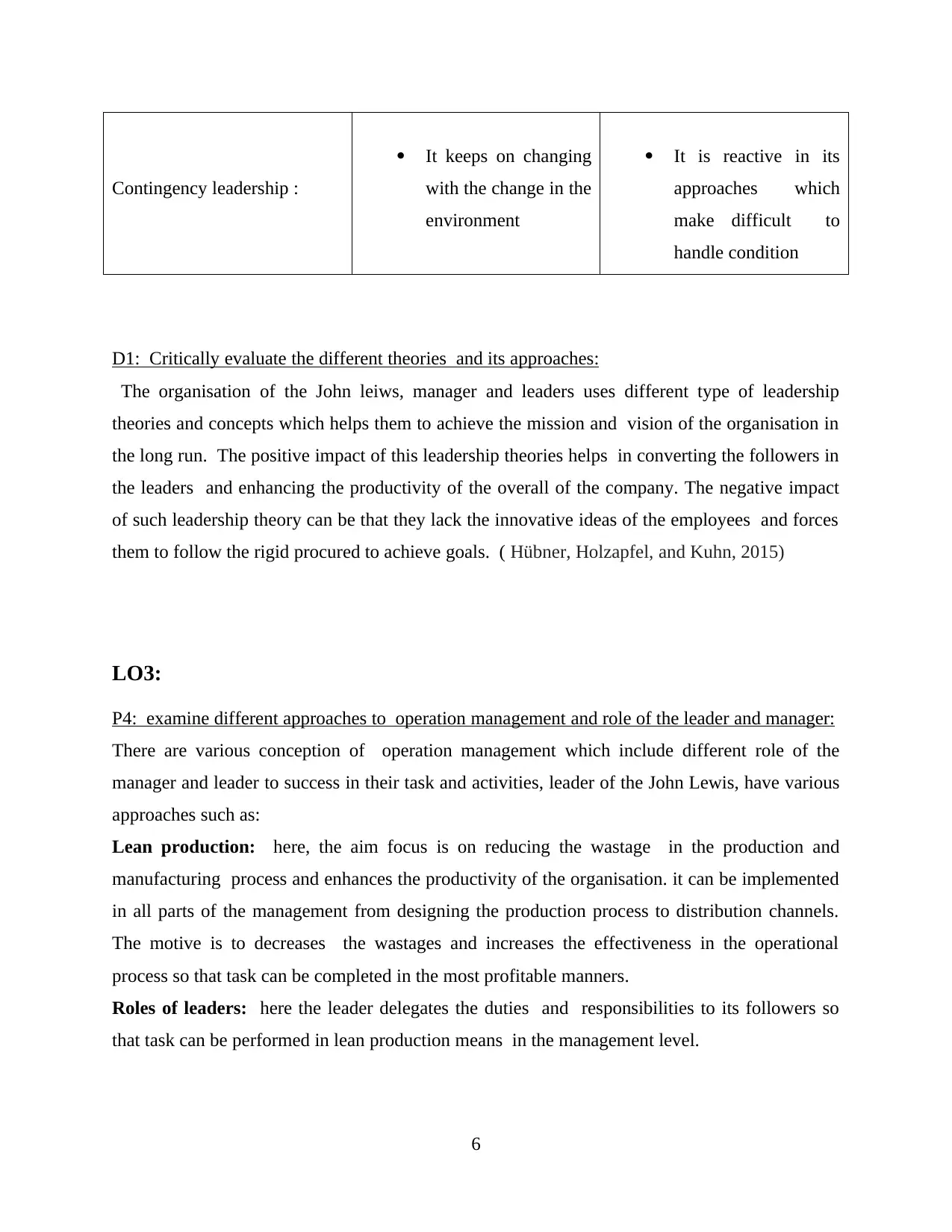
Contingency leadership :
It keeps on changing
with the change in the
environment
It is reactive in its
approaches which
make difficult to
handle condition
D1: Critically evaluate the different theories and its approaches:
The organisation of the John leiws, manager and leaders uses different type of leadership
theories and concepts which helps them to achieve the mission and vision of the organisation in
the long run. The positive impact of this leadership theories helps in converting the followers in
the leaders and enhancing the productivity of the overall of the company. The negative impact
of such leadership theory can be that they lack the innovative ideas of the employees and forces
them to follow the rigid procured to achieve goals. ( Hübner, Holzapfel, and Kuhn, 2015)
LO3:
P4: examine different approaches to operation management and role of the leader and manager:
There are various conception of operation management which include different role of the
manager and leader to success in their task and activities, leader of the John Lewis, have various
approaches such as:
Lean production: here, the aim focus is on reducing the wastage in the production and
manufacturing process and enhances the productivity of the organisation. it can be implemented
in all parts of the management from designing the production process to distribution channels.
The motive is to decreases the wastages and increases the effectiveness in the operational
process so that task can be completed in the most profitable manners.
Roles of leaders: here the leader delegates the duties and responsibilities to its followers so
that task can be performed in lean production means in the management level.
6
It keeps on changing
with the change in the
environment
It is reactive in its
approaches which
make difficult to
handle condition
D1: Critically evaluate the different theories and its approaches:
The organisation of the John leiws, manager and leaders uses different type of leadership
theories and concepts which helps them to achieve the mission and vision of the organisation in
the long run. The positive impact of this leadership theories helps in converting the followers in
the leaders and enhancing the productivity of the overall of the company. The negative impact
of such leadership theory can be that they lack the innovative ideas of the employees and forces
them to follow the rigid procured to achieve goals. ( Hübner, Holzapfel, and Kuhn, 2015)
LO3:
P4: examine different approaches to operation management and role of the leader and manager:
There are various conception of operation management which include different role of the
manager and leader to success in their task and activities, leader of the John Lewis, have various
approaches such as:
Lean production: here, the aim focus is on reducing the wastage in the production and
manufacturing process and enhances the productivity of the organisation. it can be implemented
in all parts of the management from designing the production process to distribution channels.
The motive is to decreases the wastages and increases the effectiveness in the operational
process so that task can be completed in the most profitable manners.
Roles of leaders: here the leader delegates the duties and responsibilities to its followers so
that task can be performed in lean production means in the management level.
6
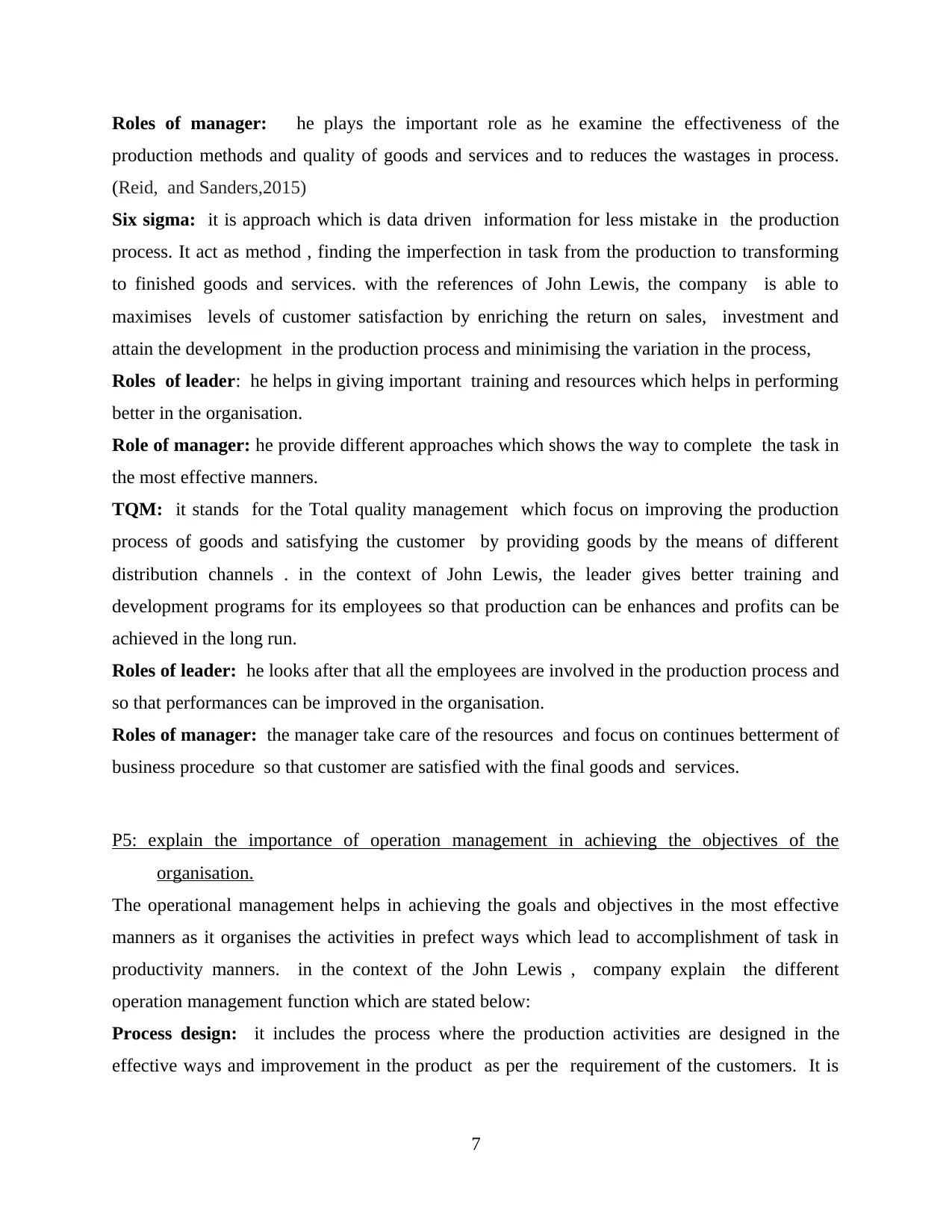
Roles of manager: he plays the important role as he examine the effectiveness of the
production methods and quality of goods and services and to reduces the wastages in process.
(Reid, and Sanders,2015)
Six sigma: it is approach which is data driven information for less mistake in the production
process. It act as method , finding the imperfection in task from the production to transforming
to finished goods and services. with the references of John Lewis, the company is able to
maximises levels of customer satisfaction by enriching the return on sales, investment and
attain the development in the production process and minimising the variation in the process,
Roles of leader: he helps in giving important training and resources which helps in performing
better in the organisation.
Role of manager: he provide different approaches which shows the way to complete the task in
the most effective manners.
TQM: it stands for the Total quality management which focus on improving the production
process of goods and satisfying the customer by providing goods by the means of different
distribution channels . in the context of John Lewis, the leader gives better training and
development programs for its employees so that production can be enhances and profits can be
achieved in the long run.
Roles of leader: he looks after that all the employees are involved in the production process and
so that performances can be improved in the organisation.
Roles of manager: the manager take care of the resources and focus on continues betterment of
business procedure so that customer are satisfied with the final goods and services.
P5: explain the importance of operation management in achieving the objectives of the
organisation.
The operational management helps in achieving the goals and objectives in the most effective
manners as it organises the activities in prefect ways which lead to accomplishment of task in
productivity manners. in the context of the John Lewis , company explain the different
operation management function which are stated below:
Process design: it includes the process where the production activities are designed in the
effective ways and improvement in the product as per the requirement of the customers. It is
7
production methods and quality of goods and services and to reduces the wastages in process.
(Reid, and Sanders,2015)
Six sigma: it is approach which is data driven information for less mistake in the production
process. It act as method , finding the imperfection in task from the production to transforming
to finished goods and services. with the references of John Lewis, the company is able to
maximises levels of customer satisfaction by enriching the return on sales, investment and
attain the development in the production process and minimising the variation in the process,
Roles of leader: he helps in giving important training and resources which helps in performing
better in the organisation.
Role of manager: he provide different approaches which shows the way to complete the task in
the most effective manners.
TQM: it stands for the Total quality management which focus on improving the production
process of goods and satisfying the customer by providing goods by the means of different
distribution channels . in the context of John Lewis, the leader gives better training and
development programs for its employees so that production can be enhances and profits can be
achieved in the long run.
Roles of leader: he looks after that all the employees are involved in the production process and
so that performances can be improved in the organisation.
Roles of manager: the manager take care of the resources and focus on continues betterment of
business procedure so that customer are satisfied with the final goods and services.
P5: explain the importance of operation management in achieving the objectives of the
organisation.
The operational management helps in achieving the goals and objectives in the most effective
manners as it organises the activities in prefect ways which lead to accomplishment of task in
productivity manners. in the context of the John Lewis , company explain the different
operation management function which are stated below:
Process design: it includes the process where the production activities are designed in the
effective ways and improvement in the product as per the requirement of the customers. It is
7
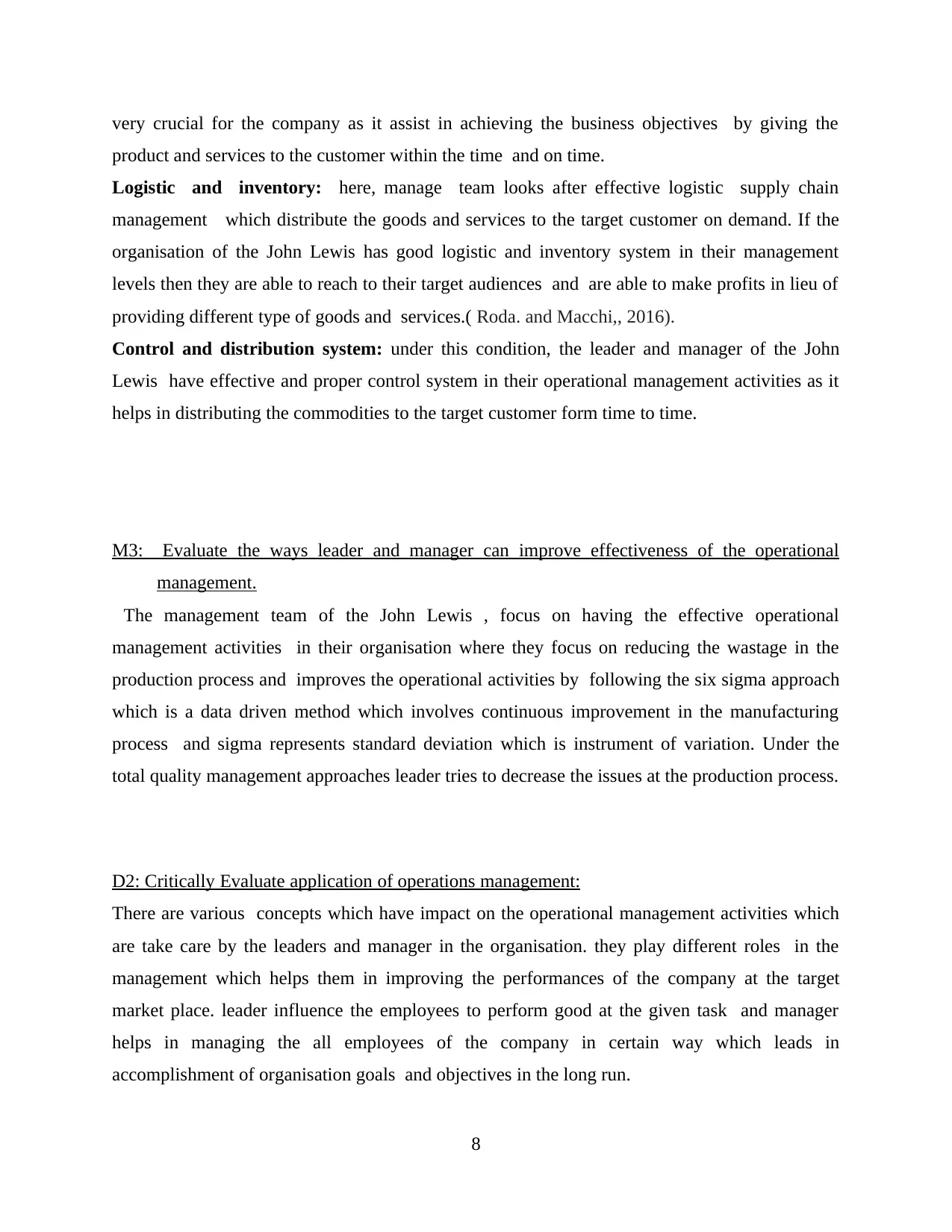
very crucial for the company as it assist in achieving the business objectives by giving the
product and services to the customer within the time and on time.
Logistic and inventory: here, manage team looks after effective logistic supply chain
management which distribute the goods and services to the target customer on demand. If the
organisation of the John Lewis has good logistic and inventory system in their management
levels then they are able to reach to their target audiences and are able to make profits in lieu of
providing different type of goods and services.( Roda. and Macchi,, 2016).
Control and distribution system: under this condition, the leader and manager of the John
Lewis have effective and proper control system in their operational management activities as it
helps in distributing the commodities to the target customer form time to time.
M3: Evaluate the ways leader and manager can improve effectiveness of the operational
management.
The management team of the John Lewis , focus on having the effective operational
management activities in their organisation where they focus on reducing the wastage in the
production process and improves the operational activities by following the six sigma approach
which is a data driven method which involves continuous improvement in the manufacturing
process and sigma represents standard deviation which is instrument of variation. Under the
total quality management approaches leader tries to decrease the issues at the production process.
D2: Critically Evaluate application of operations management:
There are various concepts which have impact on the operational management activities which
are take care by the leaders and manager in the organisation. they play different roles in the
management which helps them in improving the performances of the company at the target
market place. leader influence the employees to perform good at the given task and manager
helps in managing the all employees of the company in certain way which leads in
accomplishment of organisation goals and objectives in the long run.
8
product and services to the customer within the time and on time.
Logistic and inventory: here, manage team looks after effective logistic supply chain
management which distribute the goods and services to the target customer on demand. If the
organisation of the John Lewis has good logistic and inventory system in their management
levels then they are able to reach to their target audiences and are able to make profits in lieu of
providing different type of goods and services.( Roda. and Macchi,, 2016).
Control and distribution system: under this condition, the leader and manager of the John
Lewis have effective and proper control system in their operational management activities as it
helps in distributing the commodities to the target customer form time to time.
M3: Evaluate the ways leader and manager can improve effectiveness of the operational
management.
The management team of the John Lewis , focus on having the effective operational
management activities in their organisation where they focus on reducing the wastage in the
production process and improves the operational activities by following the six sigma approach
which is a data driven method which involves continuous improvement in the manufacturing
process and sigma represents standard deviation which is instrument of variation. Under the
total quality management approaches leader tries to decrease the issues at the production process.
D2: Critically Evaluate application of operations management:
There are various concepts which have impact on the operational management activities which
are take care by the leaders and manager in the organisation. they play different roles in the
management which helps them in improving the performances of the company at the target
market place. leader influence the employees to perform good at the given task and manager
helps in managing the all employees of the company in certain way which leads in
accomplishment of organisation goals and objectives in the long run.
8
Secure Best Marks with AI Grader
Need help grading? Try our AI Grader for instant feedback on your assignments.
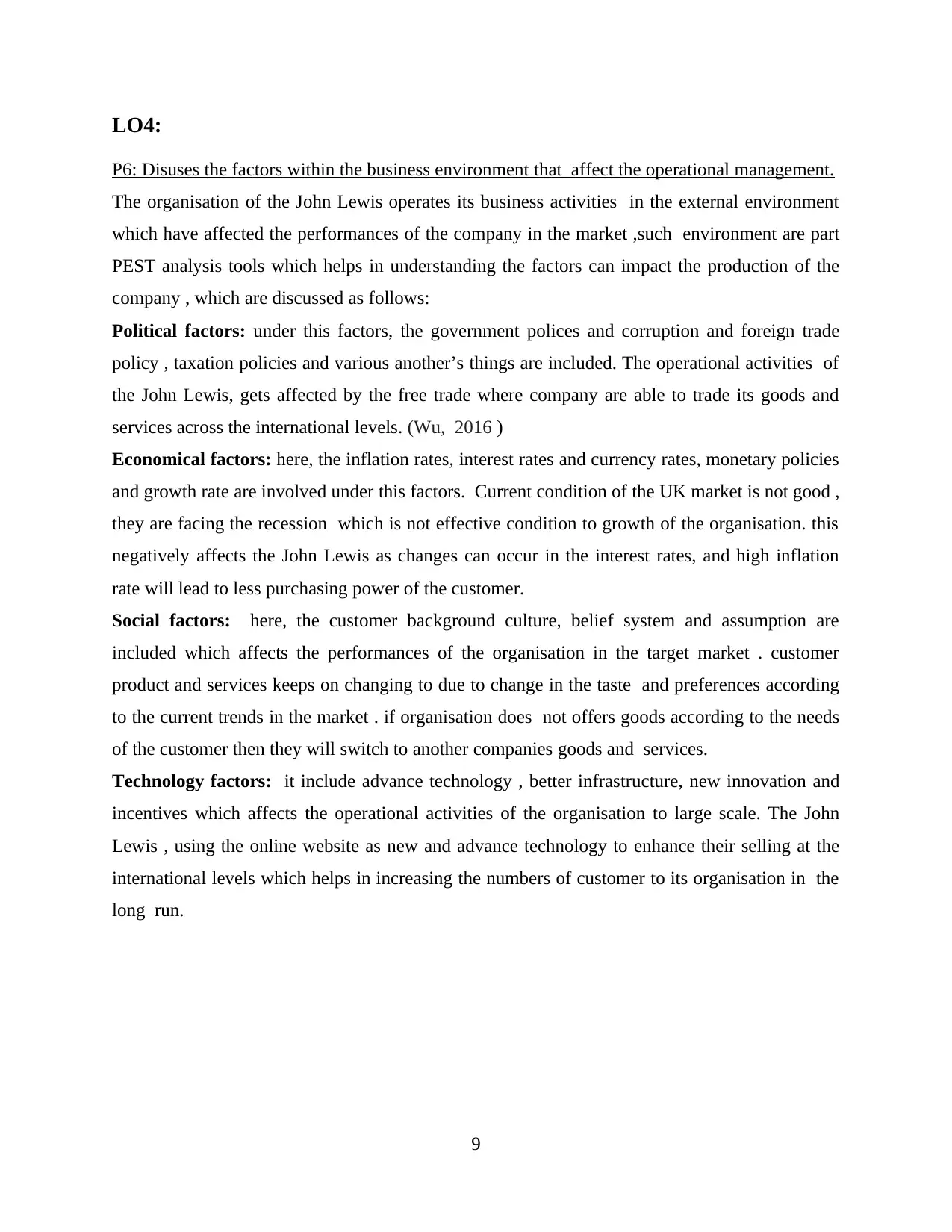
LO4:
P6: Disuses the factors within the business environment that affect the operational management.
The organisation of the John Lewis operates its business activities in the external environment
which have affected the performances of the company in the market ,such environment are part
PEST analysis tools which helps in understanding the factors can impact the production of the
company , which are discussed as follows:
Political factors: under this factors, the government polices and corruption and foreign trade
policy , taxation policies and various another’s things are included. The operational activities of
the John Lewis, gets affected by the free trade where company are able to trade its goods and
services across the international levels. (Wu, 2016 )
Economical factors: here, the inflation rates, interest rates and currency rates, monetary policies
and growth rate are involved under this factors. Current condition of the UK market is not good ,
they are facing the recession which is not effective condition to growth of the organisation. this
negatively affects the John Lewis as changes can occur in the interest rates, and high inflation
rate will lead to less purchasing power of the customer.
Social factors: here, the customer background culture, belief system and assumption are
included which affects the performances of the organisation in the target market . customer
product and services keeps on changing to due to change in the taste and preferences according
to the current trends in the market . if organisation does not offers goods according to the needs
of the customer then they will switch to another companies goods and services.
Technology factors: it include advance technology , better infrastructure, new innovation and
incentives which affects the operational activities of the organisation to large scale. The John
Lewis , using the online website as new and advance technology to enhance their selling at the
international levels which helps in increasing the numbers of customer to its organisation in the
long run.
9
P6: Disuses the factors within the business environment that affect the operational management.
The organisation of the John Lewis operates its business activities in the external environment
which have affected the performances of the company in the market ,such environment are part
PEST analysis tools which helps in understanding the factors can impact the production of the
company , which are discussed as follows:
Political factors: under this factors, the government polices and corruption and foreign trade
policy , taxation policies and various another’s things are included. The operational activities of
the John Lewis, gets affected by the free trade where company are able to trade its goods and
services across the international levels. (Wu, 2016 )
Economical factors: here, the inflation rates, interest rates and currency rates, monetary policies
and growth rate are involved under this factors. Current condition of the UK market is not good ,
they are facing the recession which is not effective condition to growth of the organisation. this
negatively affects the John Lewis as changes can occur in the interest rates, and high inflation
rate will lead to less purchasing power of the customer.
Social factors: here, the customer background culture, belief system and assumption are
included which affects the performances of the organisation in the target market . customer
product and services keeps on changing to due to change in the taste and preferences according
to the current trends in the market . if organisation does not offers goods according to the needs
of the customer then they will switch to another companies goods and services.
Technology factors: it include advance technology , better infrastructure, new innovation and
incentives which affects the operational activities of the organisation to large scale. The John
Lewis , using the online website as new and advance technology to enhance their selling at the
international levels which helps in increasing the numbers of customer to its organisation in the
long run.
9
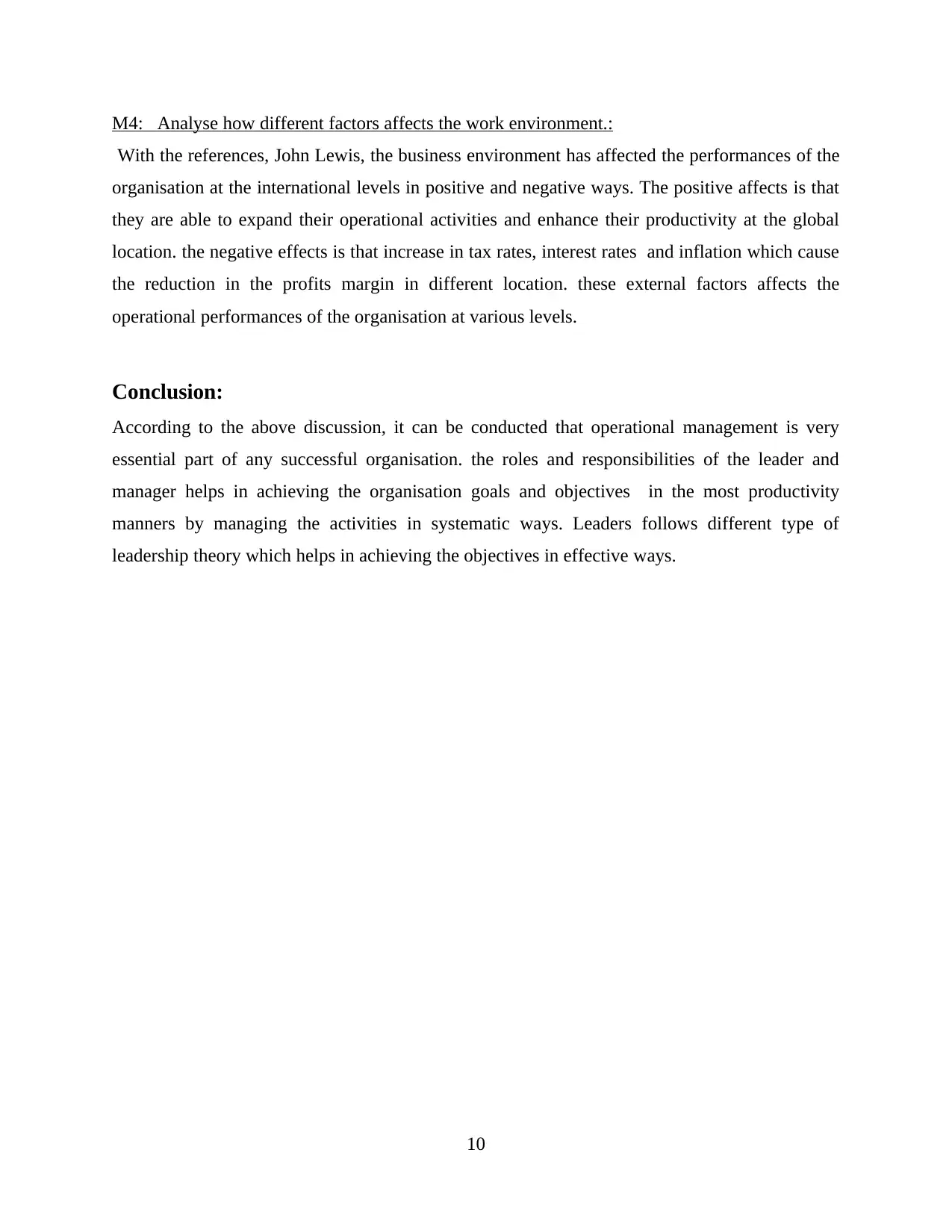
M4: Analyse how different factors affects the work environment.:
With the references, John Lewis, the business environment has affected the performances of the
organisation at the international levels in positive and negative ways. The positive affects is that
they are able to expand their operational activities and enhance their productivity at the global
location. the negative effects is that increase in tax rates, interest rates and inflation which cause
the reduction in the profits margin in different location. these external factors affects the
operational performances of the organisation at various levels.
Conclusion:
According to the above discussion, it can be conducted that operational management is very
essential part of any successful organisation. the roles and responsibilities of the leader and
manager helps in achieving the organisation goals and objectives in the most productivity
manners by managing the activities in systematic ways. Leaders follows different type of
leadership theory which helps in achieving the objectives in effective ways.
10
With the references, John Lewis, the business environment has affected the performances of the
organisation at the international levels in positive and negative ways. The positive affects is that
they are able to expand their operational activities and enhance their productivity at the global
location. the negative effects is that increase in tax rates, interest rates and inflation which cause
the reduction in the profits margin in different location. these external factors affects the
operational performances of the organisation at various levels.
Conclusion:
According to the above discussion, it can be conducted that operational management is very
essential part of any successful organisation. the roles and responsibilities of the leader and
manager helps in achieving the organisation goals and objectives in the most productivity
manners by managing the activities in systematic ways. Leaders follows different type of
leadership theory which helps in achieving the objectives in effective ways.
10
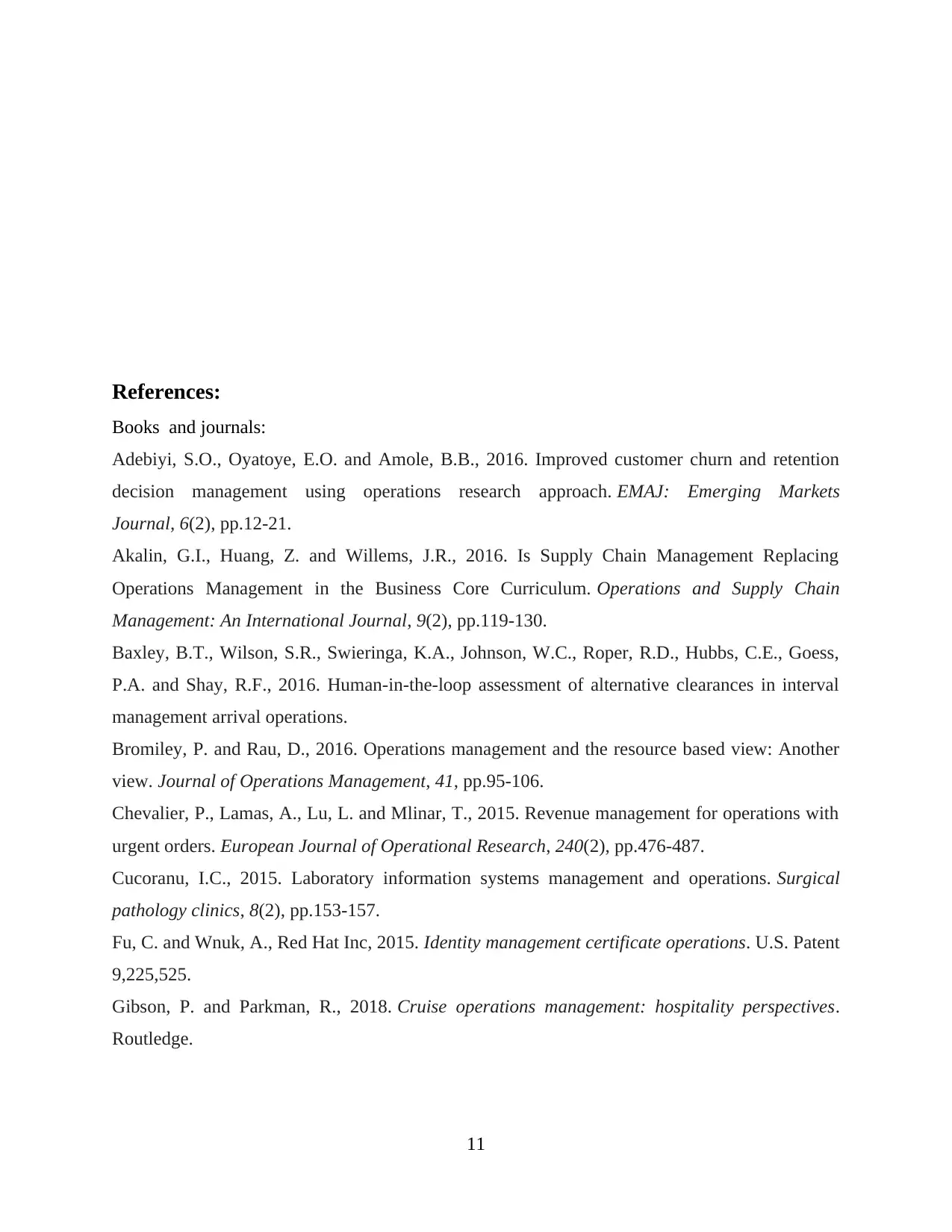
References:
Books and journals:
Adebiyi, S.O., Oyatoye, E.O. and Amole, B.B., 2016. Improved customer churn and retention
decision management using operations research approach. EMAJ: Emerging Markets
Journal, 6(2), pp.12-21.
Akalin, G.I., Huang, Z. and Willems, J.R., 2016. Is Supply Chain Management Replacing
Operations Management in the Business Core Curriculum. Operations and Supply Chain
Management: An International Journal, 9(2), pp.119-130.
Baxley, B.T., Wilson, S.R., Swieringa, K.A., Johnson, W.C., Roper, R.D., Hubbs, C.E., Goess,
P.A. and Shay, R.F., 2016. Human-in-the-loop assessment of alternative clearances in interval
management arrival operations.
Bromiley, P. and Rau, D., 2016. Operations management and the resource based view: Another
view. Journal of Operations Management, 41, pp.95-106.
Chevalier, P., Lamas, A., Lu, L. and Mlinar, T., 2015. Revenue management for operations with
urgent orders. European Journal of Operational Research, 240(2), pp.476-487.
Cucoranu, I.C., 2015. Laboratory information systems management and operations. Surgical
pathology clinics, 8(2), pp.153-157.
Fu, C. and Wnuk, A., Red Hat Inc, 2015. Identity management certificate operations. U.S. Patent
9,225,525.
Gibson, P. and Parkman, R., 2018. Cruise operations management: hospitality perspectives.
Routledge.
11
Books and journals:
Adebiyi, S.O., Oyatoye, E.O. and Amole, B.B., 2016. Improved customer churn and retention
decision management using operations research approach. EMAJ: Emerging Markets
Journal, 6(2), pp.12-21.
Akalin, G.I., Huang, Z. and Willems, J.R., 2016. Is Supply Chain Management Replacing
Operations Management in the Business Core Curriculum. Operations and Supply Chain
Management: An International Journal, 9(2), pp.119-130.
Baxley, B.T., Wilson, S.R., Swieringa, K.A., Johnson, W.C., Roper, R.D., Hubbs, C.E., Goess,
P.A. and Shay, R.F., 2016. Human-in-the-loop assessment of alternative clearances in interval
management arrival operations.
Bromiley, P. and Rau, D., 2016. Operations management and the resource based view: Another
view. Journal of Operations Management, 41, pp.95-106.
Chevalier, P., Lamas, A., Lu, L. and Mlinar, T., 2015. Revenue management for operations with
urgent orders. European Journal of Operational Research, 240(2), pp.476-487.
Cucoranu, I.C., 2015. Laboratory information systems management and operations. Surgical
pathology clinics, 8(2), pp.153-157.
Fu, C. and Wnuk, A., Red Hat Inc, 2015. Identity management certificate operations. U.S. Patent
9,225,525.
Gibson, P. and Parkman, R., 2018. Cruise operations management: hospitality perspectives.
Routledge.
11
Paraphrase This Document
Need a fresh take? Get an instant paraphrase of this document with our AI Paraphraser
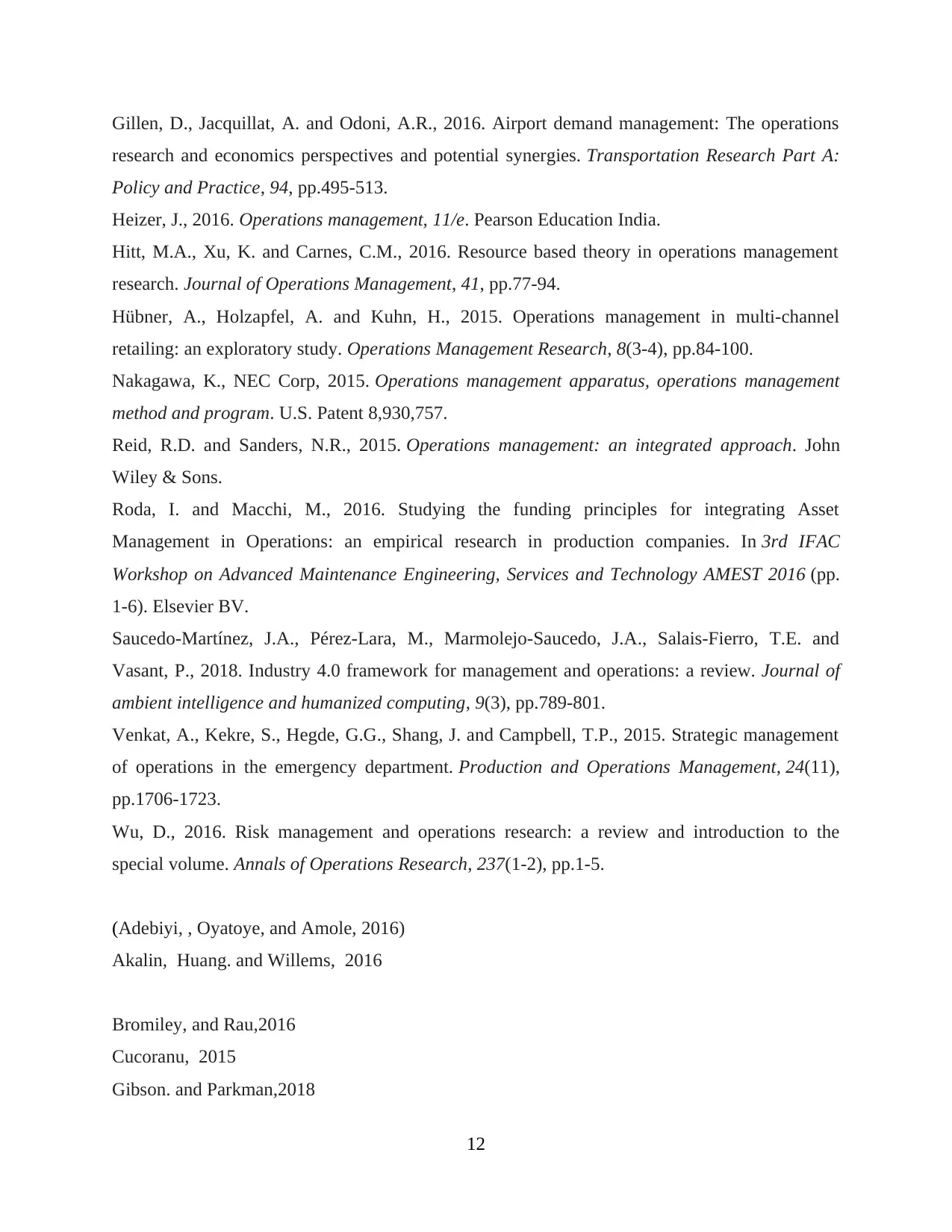
Gillen, D., Jacquillat, A. and Odoni, A.R., 2016. Airport demand management: The operations
research and economics perspectives and potential synergies. Transportation Research Part A:
Policy and Practice, 94, pp.495-513.
Heizer, J., 2016. Operations management, 11/e. Pearson Education India.
Hitt, M.A., Xu, K. and Carnes, C.M., 2016. Resource based theory in operations management
research. Journal of Operations Management, 41, pp.77-94.
Hübner, A., Holzapfel, A. and Kuhn, H., 2015. Operations management in multi-channel
retailing: an exploratory study. Operations Management Research, 8(3-4), pp.84-100.
Nakagawa, K., NEC Corp, 2015. Operations management apparatus, operations management
method and program. U.S. Patent 8,930,757.
Reid, R.D. and Sanders, N.R., 2015. Operations management: an integrated approach. John
Wiley & Sons.
Roda, I. and Macchi, M., 2016. Studying the funding principles for integrating Asset
Management in Operations: an empirical research in production companies. In 3rd IFAC
Workshop on Advanced Maintenance Engineering, Services and Technology AMEST 2016 (pp.
1-6). Elsevier BV.
Saucedo-Martínez, J.A., Pérez-Lara, M., Marmolejo-Saucedo, J.A., Salais-Fierro, T.E. and
Vasant, P., 2018. Industry 4.0 framework for management and operations: a review. Journal of
ambient intelligence and humanized computing, 9(3), pp.789-801.
Venkat, A., Kekre, S., Hegde, G.G., Shang, J. and Campbell, T.P., 2015. Strategic management
of operations in the emergency department. Production and Operations Management, 24(11),
pp.1706-1723.
Wu, D., 2016. Risk management and operations research: a review and introduction to the
special volume. Annals of Operations Research, 237(1-2), pp.1-5.
(Adebiyi, , Oyatoye, and Amole, 2016)
Akalin, Huang. and Willems, 2016
Bromiley, and Rau,2016
Cucoranu, 2015
Gibson. and Parkman,2018
12
research and economics perspectives and potential synergies. Transportation Research Part A:
Policy and Practice, 94, pp.495-513.
Heizer, J., 2016. Operations management, 11/e. Pearson Education India.
Hitt, M.A., Xu, K. and Carnes, C.M., 2016. Resource based theory in operations management
research. Journal of Operations Management, 41, pp.77-94.
Hübner, A., Holzapfel, A. and Kuhn, H., 2015. Operations management in multi-channel
retailing: an exploratory study. Operations Management Research, 8(3-4), pp.84-100.
Nakagawa, K., NEC Corp, 2015. Operations management apparatus, operations management
method and program. U.S. Patent 8,930,757.
Reid, R.D. and Sanders, N.R., 2015. Operations management: an integrated approach. John
Wiley & Sons.
Roda, I. and Macchi, M., 2016. Studying the funding principles for integrating Asset
Management in Operations: an empirical research in production companies. In 3rd IFAC
Workshop on Advanced Maintenance Engineering, Services and Technology AMEST 2016 (pp.
1-6). Elsevier BV.
Saucedo-Martínez, J.A., Pérez-Lara, M., Marmolejo-Saucedo, J.A., Salais-Fierro, T.E. and
Vasant, P., 2018. Industry 4.0 framework for management and operations: a review. Journal of
ambient intelligence and humanized computing, 9(3), pp.789-801.
Venkat, A., Kekre, S., Hegde, G.G., Shang, J. and Campbell, T.P., 2015. Strategic management
of operations in the emergency department. Production and Operations Management, 24(11),
pp.1706-1723.
Wu, D., 2016. Risk management and operations research: a review and introduction to the
special volume. Annals of Operations Research, 237(1-2), pp.1-5.
(Adebiyi, , Oyatoye, and Amole, 2016)
Akalin, Huang. and Willems, 2016
Bromiley, and Rau,2016
Cucoranu, 2015
Gibson. and Parkman,2018
12
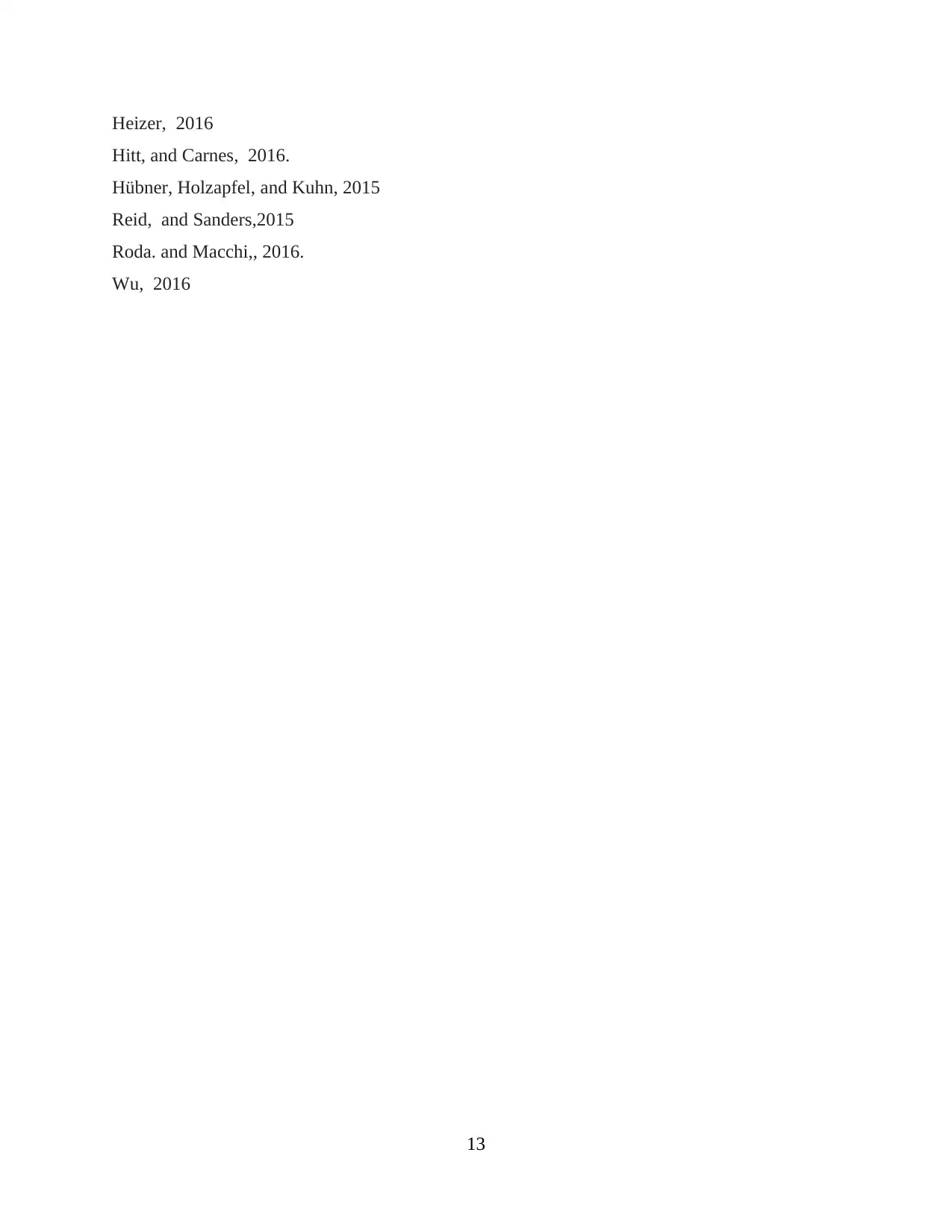
Heizer, 2016
Hitt, and Carnes, 2016.
Hübner, Holzapfel, and Kuhn, 2015
Reid, and Sanders,2015
Roda. and Macchi,, 2016.
Wu, 2016
13
Hitt, and Carnes, 2016.
Hübner, Holzapfel, and Kuhn, 2015
Reid, and Sanders,2015
Roda. and Macchi,, 2016.
Wu, 2016
13
1 out of 15
Related Documents
Your All-in-One AI-Powered Toolkit for Academic Success.
+13062052269
info@desklib.com
Available 24*7 on WhatsApp / Email
![[object Object]](/_next/static/media/star-bottom.7253800d.svg)
Unlock your academic potential
© 2024 | Zucol Services PVT LTD | All rights reserved.





